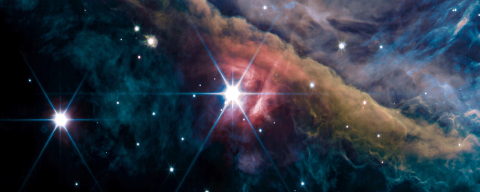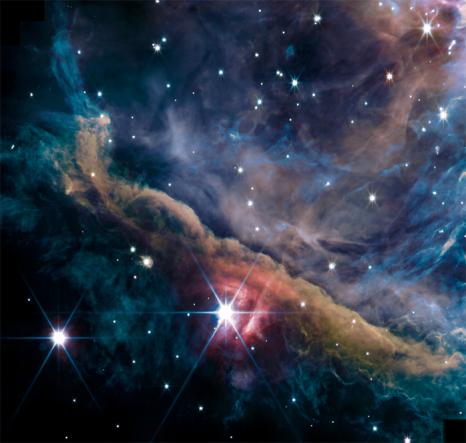
JWST witnesses the destruction of the equivalent of an ocean every month in space
An international team involving French scientists1 from Université Paris-Saclay, Université Toulouse III - Paul Sabatier, the joint laboratory INCLASS (IAS/ACRI-ST), the Observatoire de Paris-PSL, Université Grenoble Alpes, the CNRS, and CNES, has shed light on the destruction and reformation of a large quantity of water in a planet-forming disk located at the heart of the Orion Nebula. This discovery was made possible by an original multidisciplinary approach combining observations from the James Webb Space Telescope and quantum physics calculations. The study, carried out as part of the PDRs4All2 Early Release Science (ERS) programme and led by a young researcher Marion Zannese, PhD candidate at Université Paris-Saclay, has just been published in Nature Astronomy.
Water is an essential ingredient for the emergence of life as we know it. On Earth, most of the water in our oceans was formed long before the birth of the Solar System, in the cold regions of interstellar space (-250°C). However, a fraction of this water could have been destroyed and re-formed at higher temperatures (100-500°C) when the Solar System was still just a disk of gas and dust orbiting our nascent Sun.
To understand this enigmatic recycling of water, astronomers pointed the JWST towards "d203-506", a planet-forming disk located in the Orion Nebula, a planetary system nursery. The intense ultraviolet radiation produced by nearby massive stars leads to the rapid destruction and reformation of water in d203-506, making it a true interstellar laboratory.
But how can the formation and destruction of molecules located more than 1,000 light-years away be observed? A collaboration with quantum dynamics experts , was the key to meeting this challenge. When water (H2O) is destroyed by ultraviolet light, a hydroxyl radical (OH) is released with a fast spinning (rotational) state. This is followed by the emission of photons which travel to and are detected by the JWST. In total, it is estimated that the equivalent of a terrestrial ocean is destroyed every month in the young system d203-506.
However, it doesn’t end there. Via a similar mechanism of near-infrared photon emission, JWST reveals that hydroxyl is produced in abundance from atomic oxygen by the O+H2 reaction. Hydroxyl is a key intermediate in the formation of water, as it then reacts with H2 to form water via the OH+H2 reaction. The destruction/formation cycle is complete. Some of the water making up our oceans could indeed have undergone such a cycle.
©NASA/ESA/CSA/PDRs4All/Salomé Fuenmayor
References
OH as a probe of the warm water cycle in planet-forming disks
Marion Zannese, Benoît Tabone, Emilie Habart, Javier R. Goicoechea, Alexandre Zanchet, Ewine F. van Dishoeck, Marc C. van Hemert, John H. Black, Alexander G. G. M. Tielens, A. Veselinova, P. G. Jambrina, M. Menendez, E. Verdasco, F. J. Aoiz, L. Gonzalez-Sanchez, Boris Trahin, Emmanuel Dartois, Olivier Berné, Els Peeters, Jinhua He, Ameek Sidhu, Ryan Chown, Ilane Schroetter, Dries Van De Putte, Amélie Canin, Felipe Alarcón, Alain Abergel, Edwin A. Bergin, Jeronimo Bernard-Salas, Christiaan Boersma, Emeric Bron, Jan Cami, Daniel Dicken, Meriem Elyajouri, Asunción Fuente, Karl D. Gordon, Lina Issa, Christine Joblin, Olga Kannavou, Baria Khan, Ozan Lacinbala, David Languignon, Romane Le Gal, Alexandros Maragkoudakis, Raphael Meshaka, Yoko Okada, Takashi Onaka, Sofia Pasquini, Marc W. Pound, Massimo Robberto, Markus Röllig, Bethany Schefter, Thiébaut Schirmer, Sílvia Vicente, Mark G. Wolfire
Nature Astronomy 23 February 2024 https://arxiv.org/abs/2312.14056
1 In France, this work involved scientists from: Institut d’Astrophysique Spatiale (IAS – CNRS / Univ. Paris-Saclay), Institut des Sciences Moléculaires d’Orsay (ISMO – CNRS / Univ. Paris-Saclay), Institut de Recherche en Astrophysique et Planétologie (IRAP/OMP – CNES / CNRS /UT3), INCLASS Common Laboratory (IAS/ACRI-ST), LERMA (Observatoire de Paris- PSL / CNRS, Sorbonne Universités), Institut de Planétologie et d’Astrophysique de Grenoble (IPAG - Université Grenoble Alpes / CNRS), Institut de Radioastronomie Millimétrique (IRAM - UGA / CNRS / IRD / METEO-FRANCE / INRAE).
2 PDRs4All (https://pdrs4all.org/) is one of the 13 Early Release Science programmes, selected by NASA to demonstrate the capabilities of the JWST, bringing together international consortia.
3 In particular, including the contributions of scientists from: Instituto de Fısica Fundamental (CSIC) and the Department for Physical Chemistry at Universidad Complutense de Madrid (UCM) (Spain), the Department for Physical Chemistry at the University of Salamanca (Spain), the Leiden Observatory at Leiden University (The Netherlands), and the Leiden Institute of Chemistry, Gorlaeus Laboratories, Leiden University (the Netherlands).

